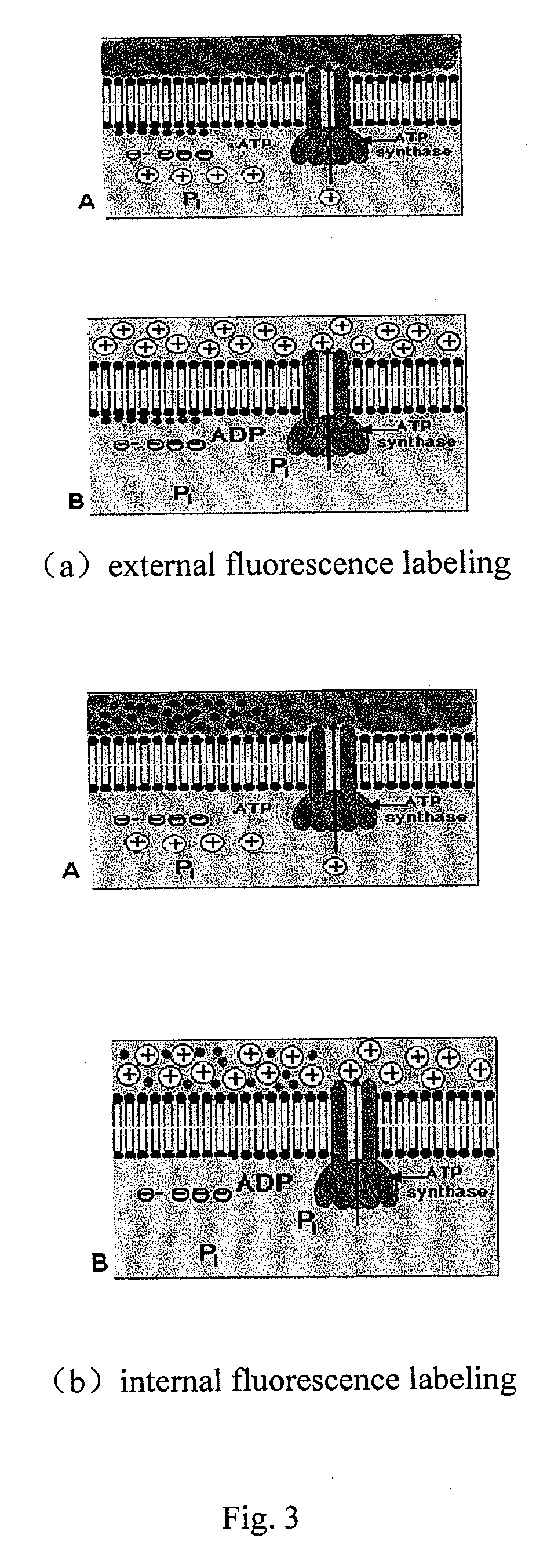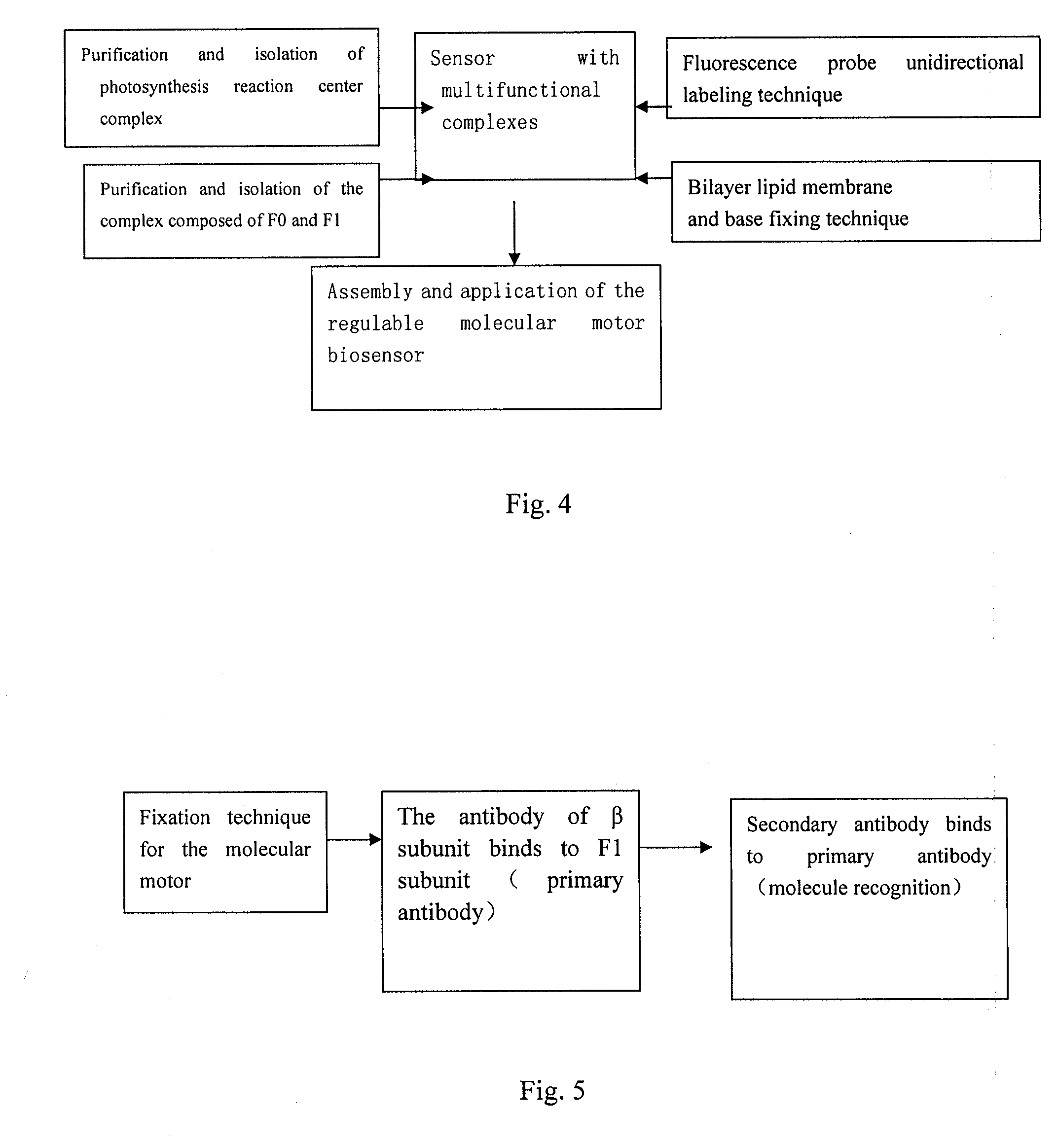Adjustable molecular motor micropower biosensor and its application
- Summary
- Abstract
- Description
- Claims
- Application Information
AI Technical Summary
Benefits of technology
Problems solved by technology
Method used
Image
Examples
example 1
The Assembly of Adjustable Molecular Motor Micro Power Biosensor
[0054]As shown in FIG. 4, the molecular motor micropower biosensor was assembled.
(1) Preparation of the Photosynthesis Complex (Chromatophores) of the Molecular Element.
[0055]Culturing photosynthesis bacteria (R. capsulatus, 120, available from the cell bank of Institute of Microorganism, Chinese Academy of Science, (Accession number 1.2359)). Culture medium: KH2PO4, 1.0 g, MgCl2 0.5 g, CaCl2 0.1 g, NaCl 1.0 g, sodium acetate 1.0 g, sodium succinate 1 g, yeast extract, 1.0 g, NaHCO3 0.5 g, peptone 0.5 g (OXOID Great Britain), trace elements 1.0 ml, vitamin solution 1.0 ml, distilled water 1.0 L, pH 6.8, 8 pounds, autoclaved for 30 minutes. Components in the vitamin solution: biotin 0.1 g (Imported), nicotinic acid 0.35 g, Thiamine dichloride 0.3 g, Ca-panthothenate 0.1 g, Vitamin B12, 0.05 g, Pyridoxolium Hydrochloride, Fluka 0.1 g, distilled water 1.0 L; components of the trace elements: FeCl2 4H2O 1.8 g; CoCl2 6H2O 0....
example 2
Fluorescence Signal of the Molecular Motor Micropower Biosensor without Load
(1) Detecting Method of the Sensor
[0060]The sample was placed onto a glass surface or into a fluorescence well (1 ml) (Hitachi apparatus, type F-4500). The sample was exited at 488 nm, with emission wavelength of 520 nm. When the sample was initiated with 2 mM ATP (Sigma company), the molecular motor of the present invention will transport the protons from the external to the internal of the cell. As a result, F1 rotated in counter-clockwise, increasing the extracellular pH from 8.0 to 9.0. At this time, the signal can be recorded conveniently by fluorescence probe Lipids-fluorescein located outside (or inside) of the cell membrane. If the molecular motor was loaded with different weight of loads (e.g., loaded with one antibody), its rotation speed will change significantly, which can be conveniently recorded by fluorescence probe Lipids-fluorescein (or fluorescein) located outside (or inside) of the cell me...
example 3
Fluorescence Signal of Molecular Motor Micropower Biosensor with Different Load
[0065]Preparation of the Antibody of the β Subunit: the Expression of Thermophilic Bacteria Bacillas PS3 and the purification of p subunit were carried out according to literatures (Science Reports, 2004, (13)1342-1347). The purified p subunit was emulsified with adjuvant in 1:1 before inoculation. The β subunit was inoculated at multiple spots on the dorsal of a 250 g rabbit (initially injected with 1 ml once every two weeks). One month later, the immunization was boosted 1-2 times to obtain polyclonal antibodies.
[0066]Based on the molecular motor micropower biosensor setup in Example 1, the p subunit primary antibody specifically bond to the p subunit of F1-ATP motor. Another IgG (goat-anti-rabbit, Sigma, Imported) secondary antibody can specifically recognize the primary antibody of the p subunit, thus completing the setup of a pair of molecular motors, the load difference between which is only of thre...
PUM
 Login to View More
Login to View More Abstract
Description
Claims
Application Information
 Login to View More
Login to View More - R&D
- Intellectual Property
- Life Sciences
- Materials
- Tech Scout
- Unparalleled Data Quality
- Higher Quality Content
- 60% Fewer Hallucinations
Browse by: Latest US Patents, China's latest patents, Technical Efficacy Thesaurus, Application Domain, Technology Topic, Popular Technical Reports.
© 2025 PatSnap. All rights reserved.Legal|Privacy policy|Modern Slavery Act Transparency Statement|Sitemap|About US| Contact US: help@patsnap.com



